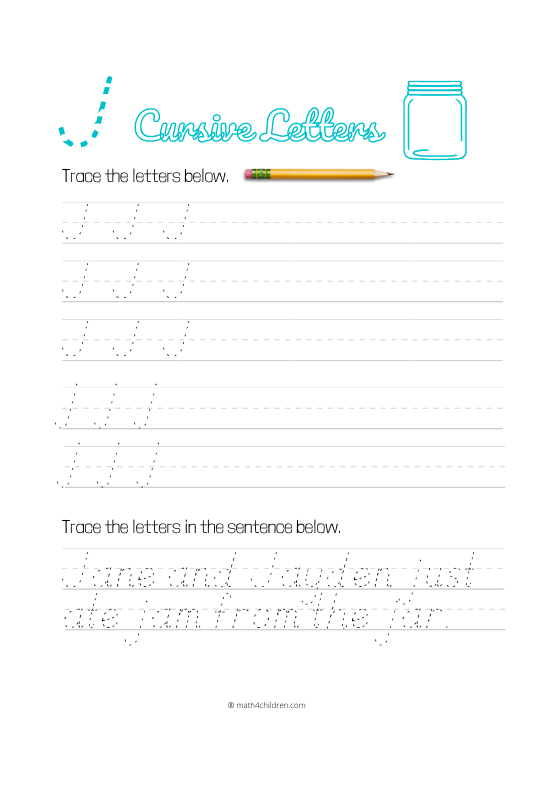![]()
John Cursive | The Art of John Cursive Writing
John Cursive - Learn how to write the name John from J.
Download all A - Z cursive letters here >>
Handwriting is a unique form of expression that has been around for centuries. While technology has made it possible to communicate with a few taps on a keyboard, there's still something special about putting pen to paper and creating something beautiful with your own hands. One of the most elegant forms of handwriting is John cursive, which is known for its flowing, ornate style. In this guide, we'll take a closer look at the art of John cursive writing and explore the techniques you need to master it.
Headings:
- What is John Cursive Writing?
- The History of John Cursive Writing
- Why Learn John Cursive Writing?
- How to Get Started with John Cursive Writing
- Tips for Mastering John Cursive Writing
- Examples of John Cursive Writing
- Common Mistakes to Avoid in John Cursive Writing
- Frequently Asked Questions about John Cursive Writing
What is John Cursive Writing?
John cursive writing is a beautiful form of handwriting that is characterized by its flowing, ornate style. It is named after John Hancock, one of the signers of the Declaration of Independence, who is known for his elegant signature. John cursive writing is also known as Copperplate or Roundhand script.
The History of John Cursive Writing
John cursive writing has been around for centuries, with roots dating back to the 16th century. It was originally developed as a form of handwriting for business and legal documents, but it soon became popular among artists and calligraphers who appreciated its elegant style. John cursive writing reached its peak of popularity in the 18th century, when it was used extensively in letter writing and formal documents.
Why Learn John Cursive Writing?
Learning John cursive writing is not only a great way to improve your handwriting, but it can also be a relaxing and meditative practice. Writing in cursive can help you slow down and focus on the task at hand, which can be beneficial for reducing stress and improving concentration. Additionally, John cursive writing is a beautiful and elegant form of handwriting that can be used to create art and decorative lettering.
How to Get Started with John Cursive Writing
Getting started with John cursive writing is easy, but it does require practice and patience. Here are the basic steps to follow:
-
Choose a pen: To write in John cursive, you'll need a pen with a flexible nib that can create thin and thick lines.
-
Practice the basic strokes: John cursive writing is made up of a series of basic strokes that are combined to form letters and words. Practice these strokes until you feel comfortable with them.
-
Learn the alphabet: Once you're comfortable with the basic strokes, you can start practicing the letters of the alphabet. Start with lowercase letters, then move on to uppercase letters.
-
Practice, practice, practice: The key to mastering John cursive writing is practice. Set aside time each day to practice your handwriting, and soon you'll see improvement.
Tips for Mastering John Cursive Writing
Here are some tips to help you master John cursive writing:
-
Practice consistently: Consistent practice is essential for improving your handwriting. Set aside time each day to practice, even if it's just for a few minutes.
-
Focus on the basic strokes: The basic strokes are the building blocks of John cursive writing. Focus on mastering these strokes, and the letters and words will come naturally.
-
Use proper posture: Sit up straight and keep your
-
Use proper posture: Sit up straight and keep your shoulders relaxed while writing. This will help you maintain good control over your pen and create smoother, more even lines.
-
Experiment with different pen grips: Finding the right pen grip can make a big difference in your handwriting. Try holding the pen in different ways to find a grip that feels comfortable and allows you to write smoothly.
-
Use lined paper: Lined paper can help you maintain consistent letter size and spacing. Make sure to use paper with guide lines that are appropriate for the size of your writing.
Common Mistakes to Avoid in John Cursive Writing
Here are some common mistakes to avoid when practicing John cursive writing:
-
Overdoing the flourishes: John cursive writing is known for its flowing, ornate style, but it's important not to overdo the flourishes. Too many flourishes can make your writing look messy and illegible.
-
Using too much pressure: John cursive writing requires a light touch. Using too much pressure can result in blotchy or uneven lines.
-
Rushing: Take your time when practicing John cursive writing. Rushing can lead to mistakes and uneven lettering.
Frequently Asked Questions about John Cursive Writing
Q: Is John cursive writing difficult to learn?
A: John cursive writing does require practice and patience, but it's not necessarily difficult to learn. With consistent practice, anyone can improve their John cursive writing skills.
Q: What kind of pen should I use for John cursive writing?
A: To write in John cursive, you'll need a pen with a flexible nib that can create thin and thick lines. Many calligraphy pens are suitable for John cursive writing.
Q: Can John cursive writing be used for everyday writing?
A: Yes, John cursive writing can be used for everyday writing, but it may take more time and effort than other forms of handwriting.
Conclusion
John cursive writing is a beautiful and elegant form of handwriting that has been around for centuries. It requires practice and patience to master, but it can be a rewarding and meditative practice. Whether you're looking to improve your handwriting or create art and decorative lettering, John cursive writing is a great skill to learn. Follow the tips and techniques outlined in this guide to start your journey to mastering John cursive writing.

